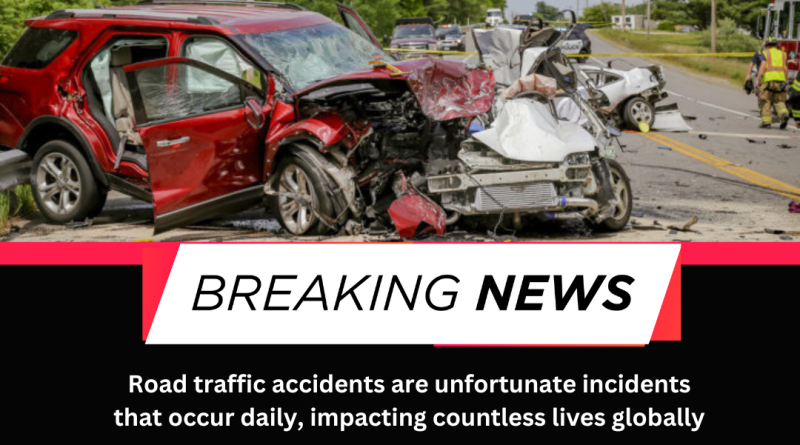traffic accident
- road traffic accident introduction:
- Road traffic accidents are unfortunate incidents that occur daily, impacting countless lives globally. These incidents involve collisions between vehicles, pedestrians, or cyclists, leading to various degrees of damage, injuries, and, in severe cases, fatalities. Understanding the causes, consequences, and preventive measures is crucial for improving road safety. Factors such as human error, road conditions, and vehicle malfunctions contribute to these accidents. Governments, law enforcement agencies, and communities play vital roles in implementing safety measures, traffic regulations, and educational campaigns to reduce the incidence of road traffic accidents. This introduction sets the stage for a comprehensive exploration of the causes, consequences, and preventive strategies associated with road traffic accidents.

- traffic accident examples:
Examples of traffic accidents can vary widely in nature and severity. Here are a few scenarios:
- Rear-End Collision:
A driver fails to brake in time, colliding with the vehicle in front at a stop sign or traffic light.
Intersection Collision:
- Two vehicles collide when one fails to yield the right of way at an intersection.
- Pedestrian Accident:
- A pedestrian is struck by a vehicle while crossing the street, often due to a driver’s failure to observe pedestrians in a crosswalk.
- Single-Vehicle Accident:
- A car veers off the road and crashes into a tree or guardrail due to factors like slippery roads, distraction, or mechanical failure.
- Multi-Vehicle Pileup:
- Several vehicles are involved in a chain reaction collision, often on highways, due to adverse weather conditions, poor visibility, or sudden braking.
- Cyclist Collision:
- A cyclist is hit by a turning vehicle or a car door opening suddenly without checking for cyclists.
- Distracted Driving Accident:
- A driver, distracted by texting or other activities, fails to notice slowing traffic, resulting in a collision.
- Drunk Driving Incident:
- A driver under the influence of alcohol or drugs causes an accident, endangering themselves and others on the road.
- T-bone Collision:
- A vehicle is struck on the side by another vehicle, often at an intersection, due to a failure to obey traffic signals or signs.
- High-Speed Crash:
Excessive speeding leads to loss of control, causing a severe collision with other vehicles or objects.
These examples highlight the diverse scenarios that can lead to traffic accidents, emphasizing the importance of responsible driving, adherence to traffic laws, and implementing safety measures to reduce the risk of such incidents.
- road traffic accident management:
- Road traffic accident management is a critical process aimed at ensuring the safety of individuals involved, minimizing traffic disruptions, and facilitating efficient resolution. Prioritize safety by moving to a secure area, assessing injuries, and promptly calling emergency services. Report the incident to local authorities, exchange contact and insurance information, and document the scene thoroughly. If possible, clear the road to restore traffic flow and provide basic first aid while awaiting professional medical assistance. Cooperate with law enforcement, obtain a police report, and arrange towing services if necessary. Notify your insurance company promptly, providing accurate details for efficient claims processing. Follow up with medical professionals and insurance providers, maintaining a record of related expenses for comprehensive accident management.
FAQ
- What is the meaning of a traffic accident:
A traffic accident, commonly referred to as a road or car accident, is an unplanned event that occurs on a road or highway involving at least one vehicle. These incidents can result in varying degrees of damage to vehicles, injuries to individuals, and, in some cases, fatalities. Traffic accidents can involve cars, motorcycles, bicycles, pedestrians, or other modes of transportation. They are often caused by a combination of factors, including human error, adverse weather conditions, mechanical failures, or violations of traffic laws. Managing the aftermath of a traffic accident involves following proper procedures to ensure the safety of those involved, reporting the incident to authorities, exchanging information, and, if necessary, seeking medical attention and insurance assistance.
- What is road traffic injury:
Road traffic injury refers to harm or damage caused by or resulting from road traffic crashes or accidents. It encompasses a broad range of injuries sustained by individuals involved in or affected by vehicular accidents on roads or highways. These injuries can vary in severity, ranging from minor cuts and bruises to more severe trauma, disabilities, or even fatalities.
The term “road traffic injury” is often used in a public health context to highlight the broader impact of road accidents beyond just fatalities. Injuries from traffic accidents can have long-term physical, emotional, and economic consequences for individuals and communities. Efforts to prevent road traffic injuries typically involve implementing safety measures, enforcing traffic regulations, promoting awareness, and improving infrastructure to create safer road environments.
- What is a transportation accident:
- A transportation accident refers to an unexpected incident or event involving vehicles or modes of transportation that results in harm, damage, or injury. This term encompasses a wide range of situations, including accidents involving automobiles, trucks, buses, trains, airplanes, ships, bicycles, and pedestrians.
Transportation accidents can occur due to various factors, such as human error, mechanical failures, adverse weather conditions, or a combination of these elements. These incidents may lead to injuries, fatalities, property damage, and disruptions to transportation systems.
Efforts to enhance transportation safety often involve implementing preventive measures, improving infrastructure, enforcing regulations, and promoting public awareness to minimize the occurrence and severity of transportation accidents across different modes of travel.
